动词时态完整版
- 格式:ppt
- 大小:1.05 MB
- 文档页数:33

时态语态〔一〕一般在表示:1.在的常性、性作 eg:IreadEnglisheverymorning.2.客真理、普遍公立、科学事eg:Thesunrisesintheeast.3.有的趣、好或能力eg:Helikesplayingfootball.4.存的性、特征或状eg:Thesituationisencouraging.5.介故事情、新eg:Workersfacetoughtimesabroad.6.按刻表或按定划、安排将要放生的作〔常如:come,go,leave,arrive,begin,start,takeoff,return,stop,open,close等〕eg:Thetrainleavesat4:30p.m.注意:here,there,now,then等开的倒装句要用一般在代替在行。
如:Look!Herecomesthebus.一般去表示:1.去常性、性的作或状eg:Heoftencriedwhenhewasaboy.2.去某的状或作eg:Iwenttothebankjustnow.3.用于Ididn’tknow⋯或Iforgot⋯,表示不知道或不得,但在道或得的事情。
eg:Ididn’tknowyouwerehere.Sorry,Iforgottobringmybook.注意:表示去常生的作,也可以用“usedtodo⋯〞和“woulddo〞一般将来表示: 1.在看来以后要生的作或存在的状eg:Tomwillcomenextweek.2.事物的固有属性或必然eg:Oilwillfloatinwater. Fishwilldiewithoutwater.3.将来某个作的安排、划eg:HeisgoingtospeakonTVthisevening.注意:将来常表达形式:will/shalldo;begoingtodo;betodo;beabouttodo 〔此形式不能与状用〕在行表示: 1.此此刻正在生的作eg:I’mstudyingEnglishnow.2.段正在生的作eg:Wearebuildingoursocialism.3.情况的性eg:Idon’treallyworkhere.Iamjusthelpinguntilthesecretaryarrives.4.与always,forever,constantly,continually 用,表示参上或等感情色彩,但并非作正在行eg:Heisalwayshelpingothers. Sheisalwaysforgettingsomething.5.按划、安排近期生的作〔只限于come,go,leave,arrive,start,move,sail,fly,travel,stay等〕eg:Aforeigneriscomingtovisitourschool. I’mleavingforBeijingtomorrow.注意:不宜用行的作:感:look,smell,feel,sound,taste,see,hear情感:like,love,prefer,admire, hate,fear 心:wish,hope,expect,want,need,believe,thin,understand,agree,know,remember,forget 所有:have,contain,won,hold,belongto去行表示: 1.去某一刻或段生的作eg:HewaswatchingTVthistimeyesterday.2.与always,forever,constantly,continually 用,表示或无等感情色彩eg:ComradeLei Fengwasalwaysthinkingofothersneverthinkingofhimself.3.去划、安排好的将来作〔只限于come,go,leave,arrive,start,move,sail,fly,travel,stay等〕eg:Hesaidhewasleavingthenextday. Iwastoldthetrainwasstartingsoon.注意:去行可用来描故事生的背景,如:Thewindwasblowinganditwasraininghard.去将来表示: 1.去某一刻后将要生的去作或去的意、打算〔主要用于从句中〕eg:She wassureshewouldsucceed. Ithoughtyouwouldcome.注意:把一般将来中的助成去式,便成了去将来的表达形式在完成表示: 1.在已完成或完成且在有影响的作eg:Ihavefinishedmyhomework.2.表示始于去持至今的作或状eg:He’slivedher esince2005. I’vetaughtEnglishfor15years.3.到目前止的一段内,多少次或第几次做某事eg:He’sbeentoBeijing severaltimes.It’sthethirdtimethatI’veseenthefilm.4.将来某将要做完的作〔限于和条件状从句〕eg:Don’tgetoffthebusuntilithas stopped.5.生在去的,但已成在的或eg:We’veallplayedwithsnowandice.注意:没有包括“在〞在内或不是截止到“在〞止的状不能与在完成用。
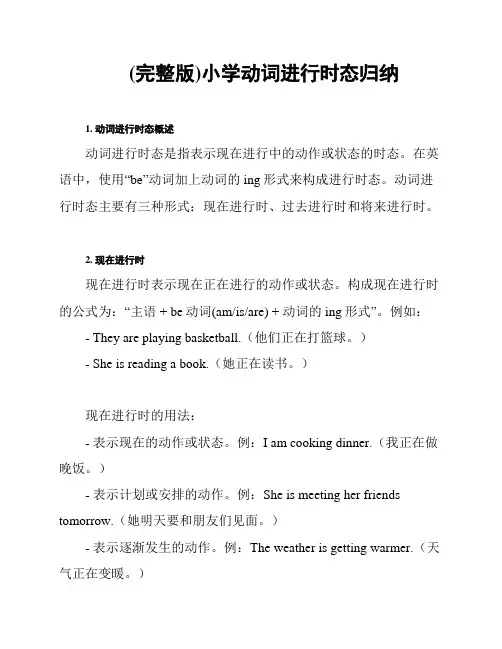
(完整版)小学动词进行时态归纳1. 动词进行时态概述动词进行时态是指表示现在进行中的动作或状态的时态。
在英语中,使用“be”动词加上动词的ing形式来构成进行时态。
动词进行时态主要有三种形式:现在进行时、过去进行时和将来进行时。
2. 现在进行时现在进行时表示现在正在进行的动作或状态。
构成现在进行时的公式为:“主语 + be动词(am/is/are) + 动词的ing形式”。
例如:- They are playing basketball.(他们正在打篮球。
)- She is reading a book.(她正在读书。
)现在进行时的用法:- 表示现在的动作或状态。
例:I am cooking dinner.(我正在做晚饭。
)- 表示计划或安排的动作。
例:She is meeting her friends tomorrow.(她明天要和朋友们见面。
)- 表示逐渐发生的动作。
例:The weather is getting warmer.(天气正在变暖。
)3. 过去进行时过去进行时表示过去某一时间正在进行的动作或状态。
构成过去进行时的公式为:“主语 + was/were + 动词的ing形式”。
例如:- They were playing football yesterday.(他们昨天正在踢足球。
)- She was studying at the library.(她那时正在图书馆研究。
)过去进行时的用法:- 表示过去某时正在进行的动作。
例:I was watching TV when she called.(她打电话的时候我正在看电视。
)- 表示过去某一段时间内持续进行的动作。
例:They were studying for hours last night.(昨晚他们研究了几个小时。
)4. 将来进行时将来进行时表示将来某一时间正在进行的动作或状态。
构成将来进行时的公式为:“主语 + will be + 动词的ing形式”。
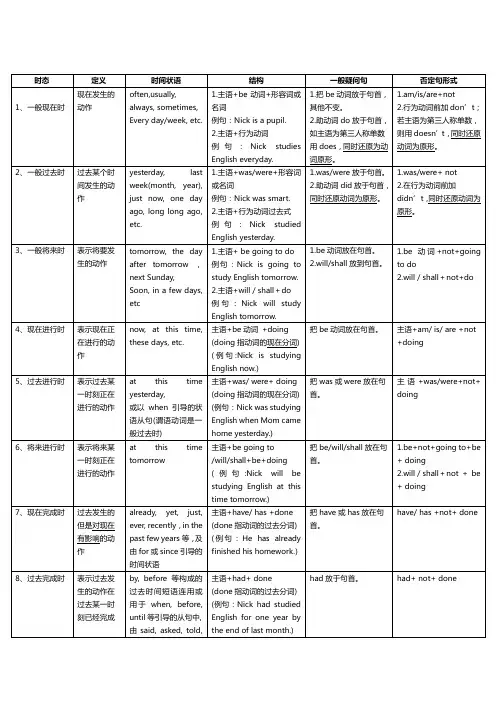

动词时态一、一般现在时am/is/are does意义:1、经常做(usually; sometimes ; often;);2、时间或条件状语从句中(if /unless/when/once/as soon as),从句用一般现在时,主句用将来时;eg: If it rains , we will not go to the park.;I will return this book to you as soon as I finish it二、一般过去是:was/ were; did ; used to do ;would do意义:1、过去发生的或过去经常做的(in 1980/yesterday/the other day前几天);过去相继发生的动作;eg Yesterday evening I opened the door, put down my bag and found that my computer was stolen.; Lucy used to exercise every day when she was at college.三、一般将来时:will be /will do /be going to do / be to do/ be about to do 意义:将要发生的动作(in the future/ tomorrow/soon很快);现在相信、认为会发生什么(believe相信/expect期望/suppose认为)eg: I will finish my homework soon,;We believe China will become one of the most powerful countries in the world.It it said that the building is to be completed in August next year.四过去将来时would do was/were to do意义:过去认为将会发生什么I thought she would marry Tom, but she didn’t.五现在完成时have/ has done意义:1、一个动作刚刚完成或一个动作好久没有发生了(already/ in the past few years/since/till now/for 3 years/up to now);Nancy has been away from her hometown for 5 years.Is there my letter? I haven’t heard from her for a long time2、过去的动作对现在造成了影响;Who has parked his car outside my door, it is bloking my way.3、第几次做什么,或已经做..几次了;(it is the first/ third time that I have …/ I have done….twice)It is my first time that I have visitied his home.六过去完成时had done意义:1、过去发生的两个动作,有先后之分,较早发生的动作用过去完成时;He didn’t arrive until the game had began2、过去本打算或期望做...而未能实现(hope/want/expect/suppose)Lucy had expected that Tom would come but he didn’t.3、出现by the end of /by the time +过去的一个时间到….时间为止By the end of last year, another new gymnasium had been completed.七将来完成时will have done意义:从现在到将来一段时间才能完成的动作关键词:by the end of /by the time +将来的时间The writer will have completed his novel by the end of 2015八现在进行时(is/ are doing )意义:1、正在做或目前阶段都在做的事;(now/look!listen)2、表达赞美或厌烦的情绪(always/constantly/)eg: Why are you angry? ----Tom is always laughing at me九过去进行时was /were doing意义:1、过去的某个时间点发生的事情;The telephone was ringing when I opened the door.2、过去一直在做;all the time/ all the afternoon.What did you do yesterday. ----we were discussing the problem all the afternoon yesterday.3、表达赞美或厌烦十将来进行时will be doing意义:将来的某个时间点在做的事情then (那时)Lucy , l et’s go to the movie tomorrow 7pm?Oh , sorry , I will be helping my mother do housework then.十一现在完成进行时(have been doing)意义:从过去到现在一直都在做Why are you so tired?I have been painting all day long today.。

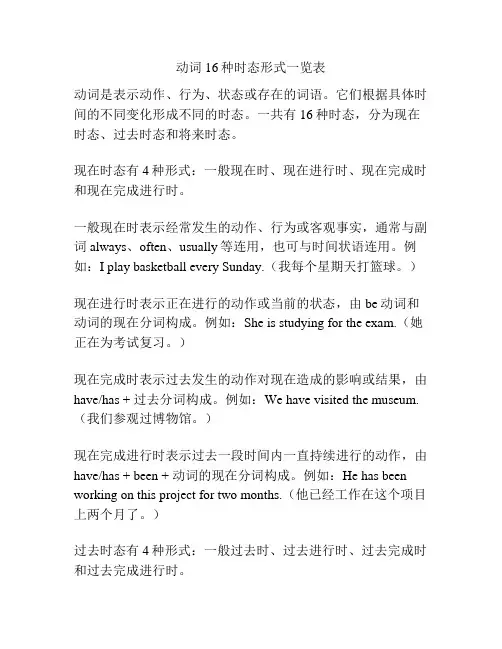
动词16种时态形式一览表动词是表示动作、行为、状态或存在的词语。
它们根据具体时间的不同变化形成不同的时态。
一共有16种时态,分为现在时态、过去时态和将来时态。
现在时态有4种形式:一般现在时、现在进行时、现在完成时和现在完成进行时。
一般现在时表示经常发生的动作、行为或客观事实,通常与副词always、often、usually等连用,也可与时间状语连用。
例如:I play basketball every Sunday.(我每个星期天打篮球。
)现在进行时表示正在进行的动作或当前的状态,由be动词和动词的现在分词构成。
例如:She is studying for the exam.(她正在为考试复习。
)现在完成时表示过去发生的动作对现在造成的影响或结果,由have/has + 过去分词构成。
例如:We have visited the museum.(我们参观过博物馆。
)现在完成进行时表示过去一段时间内一直持续进行的动作,由have/has + been + 动词的现在分词构成。
例如:He has been working on this project for two months.(他已经工作在这个项目上两个月了。
)过去时态有4种形式:一般过去时、过去进行时、过去完成时和过去完成进行时。
一般过去时表示过去某个时间发生或存在的动作、行为或状态,常与表示过去的时间状语连用。
例如:I went to the park yesterday.(昨天我去了公园。
)过去进行时表示过去正在进行的动作或状态,由过去式的be动词和动词的现在分词构成。
例如:She was sleeping when I called her.(我给她打电话的时候,她正在睡觉。
)过去完成时表示过去某个时间或动作之前已经完成的动作,由had + 过去分词构成。
例如:They had already left when I arrived.(当我到达时,他们已经离开了。


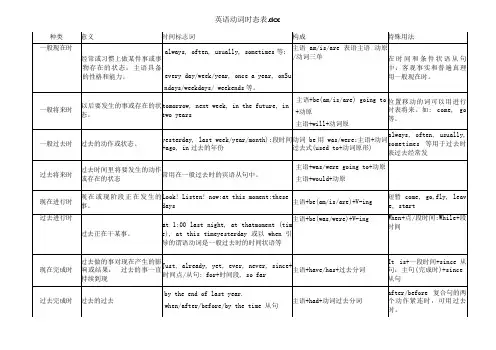
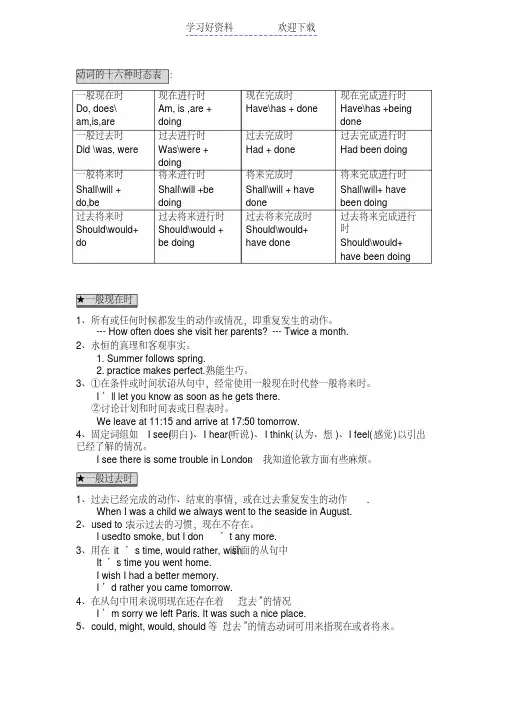
动词的十六种时态表:一般现在时Do, does\ am,is,are 现在进行时Am, is ,are +doing现在完成时Have\has + done现在完成进行时Have\has +beingdone一般过去时Did \was, were 过去进行时Was\were +doing过去完成时Had + done过去完成进行时Had been doing一般将来时Shall\will + do,be 将来进行时Shall\will +bedoing将来完成时Shall\will + havedone将来完成进行时Shall\will+ havebeen doing过去将来时Should\would+ do 过去将来进行时Should\would +be doing过去将来完成时Should\would+have done过去将来完成进行时Should\would+have been doing★一般现在时1、所有或任何时候都发生的动作或情况,即重复发生的动作。
--- How often does she visit her parents? --- Twice a month.2、永恒的真理和客观事实。
1. Summer follows spring.2. practice makes perfect. 熟能生巧。
3、①在条件或时间状语从句中,经常使用一般现在时代替一般将来时。
I’ll let you know as soon as he gets there.②讨论计划和时间表或日程表时。
We leave at 11:15 and arrive at 17:50 tomorrow.4、固定词组如I see(明白)、I hear(听说)、I think(认为、想)、I feel(感觉)以引出已经了解的情况。
I see there is some trouble in London。
我知道伦敦方面有些麻烦。
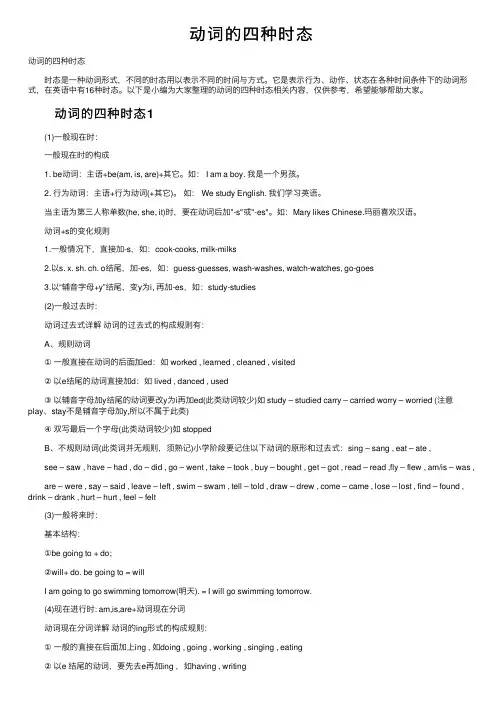
动词的四种时态动词的四种时态 时态是⼀种动词形式,不同的时态⽤以表⽰不同的时间与⽅式。
它是表⽰⾏为、动作、状态在各种时间条件下的动词形式,在英语中有16种时态。
以下是⼩编为⼤家整理的动词的四种时态相关内容,仅供参考,希望能够帮助⼤家。
动词的四种时态1 (1)⼀般现在时: ⼀般现在时的构成 1. be动词:主语+be(am, is, are)+其它。
如: I am a boy. 我是⼀个男孩。
2. ⾏为动词:主语+⾏为动词(+其它)。
如: We study English. 我们学习英语。
当主语为第三⼈称单数(he, she, it)时,要在动词后加"-s"或"-es"。
如:Mary likes Chinese.玛丽喜欢汉语。
动词+s的变化规则 1.⼀般情况下,直接加-s,如:cook-cooks, milk-milks 2.以s. x. sh. ch. o结尾,加-es,如:guess-guesses, wash-washes, watch-watches, go-goes 3.以“辅⾳字母+y”结尾,变y为i, 再加-es,如:study-studies (2)⼀般过去时: 动词过去式详解动词的过去式的构成规则有: A、规则动词 ①⼀般直接在动词的后⾯加ed:如 worked , learned , cleaned , visited ②以e结尾的动词直接加d:如 lived , danced , used ③以辅⾳字母加y结尾的动词要改y为i再加ed(此类动词较少)如 study – studied carry – carried worry – worried (注意play、stay不是辅⾳字母加y,所以不属于此类) ④双写最后⼀个字母(此类动词较少)如 stopped B、不规则动词(此类词并⽆规则,须熟记)⼩学阶段要记住以下动词的原形和过去式:sing – sang , eat – ate , see – saw , have – had , do – did , go – went , take – took , buy – bought , get – got , read – read ,fly – flew , am/is – was , are – were , say – said , leave – left , swim – swam , tell – told , draw – drew , come – came , lose – lost , find – found , drink – drank , hurt – hurt , feel – felt (3)⼀般将来时: 基本结构: ①be going to + do; ②will+ do. be going to = will I am going to go swimming tomorrow(明天). = I will go swimming tomorrow. (4)现在进⾏时: am,is,are+动词现在分词 动词现在分词详解动词的ing形式的构成规则: ①⼀般的直接在后⾯加上ing , 如doing , going , working , singing , eating ②以e 结尾的动词,要先去e再加ing ,如having , writing ③双写最后⼀个字母的(此类动词极少)有:running , swimming , sitting , getting 动词的四种时态2 ⼀般现在时 主要⽤来表⽰⼈、事物的现在状况和特点;表⽰经常或习惯性的动作,句⼦中常有often, always, from time to time 等时间状语;表⽰客观规律和永恒真理等。
完整版英语时态语态总结表完整版英语时态语态总结表英语时态是指表示动作或状态发生的时间的一种语法形式,包括一般现在时、一般过去时、一般将来时等。
而英语语态则是指表示主语与谓语动作之间关系的一种语法形式,包括主动语态和被动语态。
下面是一个完整版的英语时态语态总结表:一、一般现在时主动语态:主语 + 动词原形(第三人称单数需加-s/-es)例句:I play soccer every Saturday.(我每个星期六踢足球。
)被动语态:be动词(am/is/are) + 过去分词例句:Soccer is played by me every Saturday.(每个星期六足球都被我踢。
)二、一般过去时主动语态:主语 + 动词过去式例句:She ate an apple yesterday.(昨天她吃了一个苹果。
)被动语态:be动词(was/were) + 过去分词例句:An apple was eaten by her yesterday.(昨天一个苹果被她吃了。
)三、一般将来时主动语态:主语 + will/shall + 动词原形例句:I will go to the park tomorrow.(明天我将去公园。
)被动语态:be动词(will be/shall be) + 过去分词例句:The park will be gone to by me tomorrow.(明天公园将被我去。
)四、现在进行时主动语态:主语 + be动词(am/is/are) + 动词现在分词例句:They are playing basketball now.(他们现在正在打篮球。
)被动语态:be动词(am/is/are) + being + 过去分词例句:Basketball is being played by them now.(篮球现在正在被他们打。
)五、过去进行时主动语态:主语 + was/were + 动词现在分词例句:He was reading a book at 8 p.m. yesterday.(昨天晚上8点他在读书。
英语动词的十二种时态-CAL-FENGHAI.-(YICAI)-Company One1十二种时态形式①一般现在时:定义:表示现在阶段习惯性或经常性发生的动作或存在的状态。
构成: to do, to have, to be.Eg. I do it every day.(我每天做这样的事。
)②现在进行时:定义:表示正在进行或发生的动作。
构成:助动词be+现在分词。
Eg. I am doing it now.(现在我正在做这件事。
)③现在完成时:定义:表示过去某一动作对现在的影响或过去某一动作持续到现在,也可能还要继续下去。
构成:have/has+过去分词。
Eg. I have done it already.(我已把这件事做好了。
)④现在完成进行时:定义:表示动作从过去某一时间开始,一直延续到现在,可能还要继续下去。
构成:have/has been+现在分词。
Eg. I have been doing it for two days.(这件工作我已做了两天了。
──说话时工作尚未做完,所以还得继续做)。
⑤一般过去时:定义:表示过去某时发生的动作或存在的状态。
构成:动词+ed。
Eg. I did it yesterday.(昨天我做了这件事。
)⑥过去进行时:定义:表示过去某一时刻或某一阶段内正在进行的动作。
构成:was/were+现在分词。
Eg. I was doing it at that time.(当时我正在做这件事。
)⑦过去完成时:定义:表示在过去某一时刻以前已经完成的动作,强调“过去的过去”。
构成:had+过去分词。
Eg. I have done it before I went home yesterday.(昨天我在回家之前就把那件工作做完了)。
⑧过去完成进行时:定义:表示动作从过去,某一时间之前开始,到某一时间仍在进行或刚刚结束。
构成:had been+现在分词。
Eg. I had been doing the work for two hours when the teacher came.(老师来时那件工作我已做了两小时了。
动词的各种时态归纳一、一般现在时构成:主语+谓语(主谓一致,需注意主语为单三时,谓语动词用单三) 时间状语:常与表示频率的时间状语连用,如usually, often, always, sometimes,never, every day, once a week 等.用法:⑴表示经常发生或习惯性的动作或状态.eg: He always goes to work by subway.他总是乘地铁去上班.I visit my grandmother once a week.我一周去看望一次我的祖母.Mary does exercise every day.玛丽每天做运动.(2)表示客观事实或普遍真理,也用在格言中.eg: Light travels faster than sound.光比声音传播的快.Pride goes before a fall.骄傲使人失败.⑶表示按方案或时间表将要发生的事儿,其后常跟表示将来的时间状语. The plane takes off at four PM.飞机下午4点起飞.When does the school begin?学校什么时候开学?(4)表示主语现在的特征性格或状态.Jenny loves music.珍妮喜欢音乐.She lives in a small apartment.他住在一套小公寓里.(5)一些表示心理意识的动词,如know, understand, remember等无进行时,只能用一般现在时表示现在发生的具体行为.eg: I still remember the frightening experience on the island.我仍然记得在那个岛上的可怕经历.⑹在时间和条件状语从句中代替一般将来时.eg: I'll think about it when I write my report.我写报告时会对此予以考虑的.If he comes, I'll let you know as soon as possible.如果他来的话,我会尽快让你知道.二、现在进行时构成:主iu+be+doing时间状语:常与now, right now, at present, at the moment 等时间状语及look, listen等标志词连用.用法:⑴表示说话时正在进行的动作.eg: We are waiting for the subway at the moment.我们现在正在等地铁.Listen! Somebody is singing.听!有人在唱歌.⑵表示现阶段正在进行,而此刻不一定在进行的动作.成语表示一段时间的状语连用,如these days, this week等.eg: How are you getting on with your classmates these days?这些天你和同班同学相处的如何?We are studying French this semester.我们这学期学习语法.⑶某些非延续性动词可以用现在进行时表示即将发生的动作.常用的这类动词有come, go, leave, arrive, start, finish, die 等.这时剧中一般有表示将来的时间状语.eg: They are living by train tonight.他们今晚坐火车走.We are starting work at 8 o'clock next month.下个月我们将8点开始上班.(4)表达特定的感情色彩.现在进行时常与always, continually, constantly, forever等表示频率的副词连用,表示重复的动作,常含有厌烦,不满,抱怨,赞扬等感情色彩.试比拟:She is always scolding her child.她总是训斥自己的孩子.〔不满〕She always scolds her children.他总是训斥自己的孩子.〔事实〕He is constantly doing good work at school.他在学校总是成绩优秀.〔赞扬〕He does good work at school.他在学校成绩优秀.〔事实〕三、现在完成时构成:主语+ha ve/has+done标志词:常与already, just, yet, before, recently, so far, ever, never, once 等连用.用法:⑴表示过去发生的动作,对现在造成的影响或结果.eg: They have already learned two languages.他们己经学会了两种语言.He hasn't made a remark on the structure yet.他尚未对该结构发表评论.I have seen the linguist only once this year.我今年只见过那位语言学家一次.⑵表示从过去某一时间开始持续到现在的动作或状态.常与表示一段时间的状语连用,如so far, up to now, for a long time, for years, since 2021, in the past/ last five years, these days 等. eg: Tom and mary have been friends for years.汤姆和玛丽是多年的朋友.He has lived in London since 2000.自从2000年以来他就住在伦敦.How many words have you learned these days?这些天你学会了多少单词?⑶在时间和条件状语从句中代替将来完成时.eg: I will go to the party as soon as I have finished my homework.我一完成作业就去参加聚会.I will not believe you unless I have seen it with my own eyes.除非亲眼看到,否那么我是不会相信你的.(4)在This/ It is the first /second time that 句式中,that 从句用现在完成时. eg: It's the first time that I have come to Harvard University.这是我第1次来哈佛大学.四、一般过去时构成:主语+动词过去式时间状语:yesterday, last..., ...ago, in+过去年份等.用法:(1)表示过去某个特定时间发生的动作或存在的状态.eg: He offered his seat to an old man.他把他的座位让给了一位老人.He had a nice encounter with that girl last week.上周我与那个女孩有一次美丽的邂逅.⑵表示过去某一段时间内经常性或习惯性的动作.eg: When I was a teenager, I played table tennis almost every day.我十几岁时几乎每天都打乒乓球.⑶在时间和条件状语从句中代替过去将来时.eg: They said they would let us know if they heard any news about him.他们说如果听到关于他的任何消息,他们就会通知我们.五、一般将来时构成:主语+shall/will+动词原形时间状语:常与tomorrow, next week, in the future, in a few days等时间状语连用.用法:表示将要发生的动作或存在的状态.eg: I shall leave for London tomorrow.我明天要去伦敦.A simple test will show if this is real gold.一个简单的测试将会证实这是不是真金.其他表达方式:(1)be going to do表示打算方案安排要做某事,或有迹象说明要发生某事.eg: What are you going to do during the summer holiday?暑假你打算做什么?Look at the dark clouds! It's going to rain.瞧那些乌云!就要下雨了.(2)be about to do表示即将发生的动作,一般不与具体的时间状语连用.eg: Be quiet! The lecture is about to start.安静!讲座马上就要开始了.⑶ be to do表示根据约定责任义务或要求等即将发生的动作. eg: We are to meet at the school gate.我们约好在校门口见.。